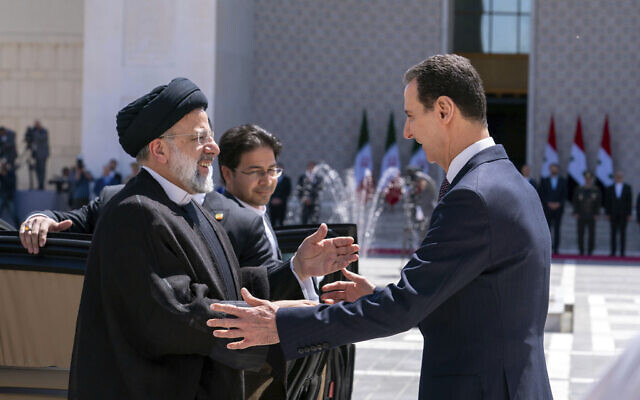Co-published with The Conversation:
In the carefully-framed photograph released by their State news agencies on May 3, the two men are beaming. Syria’s leader Bashar al-Assad has his arms outstretched and wide to welcome Iran President Ebrahim Raisi.
It is a sign of Tehran’s essential support for Assad, more than 12 years after his bloody repression of an uprising for rights and reforms. It is an attempt to portray that both leaderships are stable and in control amid Assad’s quest for “normalization” and re-entry into the regional community of nations.
It is a facade.
The template agreements for “strategic cooperation” and declaration of Iranian support for Assad via “sovereignty” cannot knit together a Syria which is fractured, perhaps for the long term. They cannot provide relief for Syrians facing inflation and shortages of food, fuel, and utilities, let alone the 11 million — almost half of the pre-conflict population — who are refugees or internally displaced.
Nor can they sweep aside nine months of Iran’s nationwide protests, sparked by the death in police custody of Mahsa Amini after her detention and reporting beaten for “inappropriate attire”. They cannot end the standoff over Tehran’s nuclear programme or lift US and European sanctions. And despite Iran-backed attacks on American personnel in the region, they cannot break US support for the Kurdish administration in northeast Syria.
Meanwhile in Kazakhstan
Seven weeks after the Assad-Raisi photo in Damascus, another international meeting testified to the illusions of an Iran-Syria “Axis of Resistance”.
In Kazakhstan’s capital, the Assad regime was joining the 6 1/2-year “Astana process” of Iran, Russia, and Turkey for the first time. This would be a marker of Damascus being on the inside of a supposed resolution of the March 2011 uprising.
But as soon as the session began, illusion met reality. The regime’s Deputy Foreign Minister Ayman Sousan demanded Turkey withdraw its forces from opposition territory in northwest Syria.
The Turks unsurprisingly refused. They wanted the gathering to put pressure on the Kurdish administration in northeast Syria, which Ankara sees as part of the Turkish Kurdish insurgency of the PKK.
But that raised the challenge of confronting the US, the backer of the Kurds and the Syrian Democratic Forces who had helped evict the Islamic State from the country in 2019. Russia, embroiled in Vladimir Putin’s failing invasion of Ukraine, showed no appetite for the task.
So everyone went home with nothing beyond Moscow’s declaration, “This is a very crucial process.”
The Unyielding Kaleidoscope
The two days in Astana highlighted the difficulty for both the Assad regime and Iran. In a Middle East kaleidoscope of many moving pieces, it is daunting for either to line up all of them.
Assad’s headline ploy has been the restoration of relations with Arab States, hoping to break political isolation and his economic bind. There has been success: UAE and Bahrain re-opening embassies; Assad’s visits to the Emirates and Oman; and re-entry into the Arab League in May, with Saudi Arabia — once the leading supporter of anti-Assad factions — welcoming Assad to the summit in Jeddah.
However, that process runs head-on into Assad’s reliance on Iran to maintain control over even part of Syria, given the long-time rivalry between Tehran and some Arab states — notably Saudi Arabia — throughout the region.
The solution to the conundrum is a grand reconciliation, in which the Islamic Republic would also repair its position in the region. In March, Iran and Saudi Arabia announced the resumption of diplomatic ties more than seven years after they were broken. The China-brokered deal was accompanied by a high-level Iranian visit to the UAE. Tehran spoke loudly about the prospect of billions of dollars of Gulf investments in its battered economy.
The maneuvers freed the Iranian leadership from an immediate crisis. Amid the nationwide protests, its currency had almost halved in value, breaking the 600,000:1 mark v. the US dollar. Easing of tensions with the Arab states, as well as talk of an “interim deal” with the US over the nuclear programme, raised the rial back to about 500,000:1. That in lifted pressure on an official inflation rate of 50%, with increases for food about 75% per year.
But this is a tentative respite. Saudi Arabia and Iran remain on opposite sides in the Yemen civil war. They back different factions in Lebanon’s long-running political and economic turmoil. Gulf States are wary about renewal of Iran-backed attacks on Iraqi bases which host US personnel, as well as any further Tehran move towards the capacity for a nuclear weapon.
Meanwhile, the International Crisis Group summarizes the never-ending corrosion in the Assad-held part of Syria.
No Gulf country is likely to want to spend significant sums in support of his regime. Syria is far from their top priority, and it offers poor returns on investment. They cannot realistically hope to compete with the influence Iran has built through years of military engagement. Western sanctions limit potential economic gains, and US sanctions in particular impose major legal barriers and political costs.
Moreover, investing large amounts in a Syria with a devastated infrastructure, an impoverished population with little purchasing power, a predatory regime and dismal security in the areas it nominally controls would be like pouring money into a bottomless pit.
Posing Amid Destruction
Assad can still pose before the cameras to claim legitimacy. But his Iranian backers are entangled in domestic difficulties, his Russian backers are being sapped of strength by Vladimir Putin’s deadly folly in Ukraine, and his would-be Arab escape route is far from assured.
And there is always the reminder of the destruction he has wrought.
On June 29, in an 83-11 vote, the UN General Assembly approved an independent body to determine the fate of more than 130,000 people — many of them “disappeared” by the regime — who have gone missing since March 2011.
This vote is an outstanding win for the victims' movements worldwide pic.twitter.com/A2P4hmzCWJ
— Ahmad Helmi (@Ahmad_helmi_0) June 29, 2023


[Editor’s Note: Despite the increase, Iran’s oil production is almost 20% below the level of 3.8 million barrels per day in January 2018.]
Iran Boosts Oil Output To 3.1 Million Bpd: https://oilprice.com/Energy/Energy-General/Iran-Boosts-Oil-Production-To-31-Million-Bpd.html
“Iran has boosted output by nearly 1 million bpd since President Ebrahim Raisi took office in August 2021. Iranian oil production increased from 2.2 million bpd back then to 3.1 million now.”
Most of the crude output is refined with the rest exported.
Iran Tries To Quell Scandal Over Official’s Same-Sex Video
https://www.iranintl.com/en/202307240223
Forbes: Iran’s Rial is World’s “Weakest” Currency
https://iranwire.com/en/economy/118803-forbes-irans-rial-is-worlds-weakest-currency/
Iran Is Breaking Out of Its Box: https://www.foreignaffairs.com/iran/breaking-out-its-box-washington-tehran-regional-influence
“Tehran has not just accelerated rapprochement with Saudi Arabia. It has embarked on a charm offensive across the Arab world, seeking to re-establish diplomatic ties and economic influence in Bahrain, Kuwait, Oman, the United Arab Emirates, Egypt, and elsewhere. Iran sees an opening to take advantage of the United States’ confused and diminished ambitions in the Middle East, and its moves are contributing to the further displacement of the United States there.”
[Editor’s Note: The commenter is wrong. The US presence in Syria has been sanctioned by Congress, since it was part of the fight against the Islamic State. And there is no finding in international law that it is illegal, given the fractured state of Syria and competing claims of authority.]
“And despite Iran-backed attacks on American personnel in the region, they cannot break US support for the Kurdish administration in northeast Syria.”
The Kurdish ministate in Syria (The Autonomous Administration of North and East Syria) has no international recognition or support. The U.S troop presence in Syria is illegal – the Congress has not approved it – and is not authorised by the United Nations. The awarding of contracts to U.S oil firms to exploit Syrian resources is also illegal. As in Iraq and Afghanistan, U.S forces will have to withdraw.
[Editor’s Note: Commenter is resorting to disinformation here. The US military presence in northeast Syria is in support of a Kurdish administration which has the de facto authority. And the line about the US “extracting natural resources” is a blatant falsehood pushed by the Kremlin, the Assad regime, and their supporters.]
“And there is no finding in international law that it is illegal, given the fractured state of Syria and competing claims of authority”
Generally, occupying part of a country and extracting its natural resources is considered illegal under international law. The Syrian state is recognized as the sole authority over the whole territory of the country by the United Nations. By the same logic, other states have the right to occupy Yemen or Somalia or even Haiti. Does the editor also think the United States has the right to intercept shipments of Iranian oil and gas as some Congressmen are demanding?
[Editor’s Note: The legitimacy of the Kurdish authority is recognized by a number of states, de facto, if not as a de jure state.
There is no de facto “State sovereignty” in northeast Syria, given that the Assad regime lost control of the area despite its repression.
The Kurdish authority is the controlling agency of the oil reserves in the northeast, not the US.]
The US military presence in northeast Syria is in support of a Kurdish administration which has the de facto authority.
The U.N and no state, including the United States, recognizes the authority of the Kurdish regime in NE Asia.
“And the line about the US “extracting natural resources” is a blatant falsehood pushed by the Kremlin, the Assad regime, and their supporters.”
The U.S is in control of 90% of Syrian reserves: https://www.npr.org/2020/03/11/814353608/u-s-troops-aim-to-keep-oil-fields-from-syrian-and-russian-forces
“U.S. forces in northeastern Syria have a relatively new mission: securing oil fields not only from ISIS, but also from Syrian government and Russian forces.”
The U.S has awarded extraction rights to an American company: https://www.politico.com/news/2020/08/03/delta-crescent-energy-syrian-oil-391033
The goal is to deny revenues to the Syrian government: https://edition.cnn.com/2020/08/05/politics/syria-secretive-oil-contract-delta-force-ambassador/index.html
“A key objective of the deal, which covers about 60% of the oil under the SDF’s control, is to cut Assad out from any of the revenue produced by the newly-developed oil fields.”
Syria and Iran have a 40 year strategic partnership. Syria was the only Arab state to support Iran, not Saddam Hussein’s Iraq, in the 1980s (the United States supported the Iraqi dictator). Iran provided economic and military aid to Syria from 2012 onwards.
#Where_Is_Mahmonir?
https://iranwire.com/en/women/118489-where_is_mahmonir/
Iran Is So Weak, Russia And China Ignore Its Interests – Ex-Diplomat
https://www.iranintl.com/en/202307131696
Disputed Maritime Field A Test Of Newly Restored Iran-Saudi Ties
https://www.iranintl.com/en/202307124822
SA didn’t even bother to invite iran to be part of discussions…..what test???
Russia Sides With UAE Over Iran’s Persian Gulf Islands
https://www.iranintl.com/en/202307110951
China did and took similar position few months ago. So much for relying on the east….